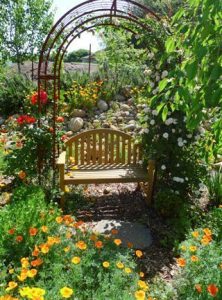Long ago, our yards were part of a vast wilderness. Then European settlers came and built farms and houses displacing the view. Today many of us yearn to recreate a portion of those beautiful, flower-covered hillsides in our own yards.
This is now the time of year to think about what we want our gardens to look like next spring, and even into the warmer months. Shall we use native plants or wildflowers? Maybe our goal is a bee and butterfly garden or a hummingbird habitat. Plan and plant this fall to enjoy the results next year.
For variety, think about growing several garden plots within your yard or perhaps planting one small space each year. Here are suggestions for different kinds of garden themes:
Native Plants
With climate change and the lack of water, as well as its expense, it is best to lean towards drought-tolerant natives. Remember they will need regular water the first year until they have adapted to their new home. Install a drip system for easy and efficient watering. Then, other than grooming and occasional weeding, just enjoy.
Try Ceanothus (California lilac), gooseberries or currents (Ribes), honeysuckles, monkey flowers (Mimulus) and sages. Buckwheat (Eriogonum) is also easy to grow, looks great and needs little care or water. You can find these plants at the California Native Plant Society’s native plant sale coming to Rocca Park in Jamestown on Saturday, October 11th, 9:00am -12 noon. Talk to the experts at the sale for advice on the right plant for you. Plants sell quickly, so get there early.
Wild Flowers
To start your wildflower garden, pick a site that has drainage so that seeds will not sit in water causing them to rot. A hillside or slanting slope is ideal. A site that is already supporting grasses and weeds has the proper nutrient needs for vigorous wildflower growth. California poppies are among our most easily grown wildflowers. Some are still showing their color here in September. Lupine, Clarkia, and baby blue eyes and five spot (Nemophila) are other possibilities.
Clear the planting area of weeds and sow wildflower seeds through early November. Also try sowing seeds in March and April. Tamp down the seeds and water lightly. If feasible, cover seeds with a thin layer of organic mulch. For germination, wildflower seeds initially require consistent moisture and freedom from weed competition.
Bee, Butterfly and Hummingbird Plants
I could almost pet these gentle creatures when they are out pollinating my garden, but when growing up, my wise mother said not to bother them when they are working.
Providing wildlife food and water is essential. Larger patches of one single plant type allow bees and butterflies to forage for nectar and pollen in a single spot for a longer period of time, rather than wasting energy searching the whole yard.
A bird bath is a good source of water for all your garden visitors. Keep it clean and consistently available, or your visitors will not benefit from your gift. Pesticides are harmful to all the animals, and especially the insects you are trying to attract.
Plants that entice butterflies include black-eyed Susan (Rudbeckia) and asters. Hummingbirds will visit many sages including Salvia spathecea (hummingbird sage) and Salvia microphylla ‘Hot Lips’.
Have fun experimenting with different plants and flowers and enjoy watching all the wildlife that will soon be visiting your garden.
Jim Gormely is a UCCE Master Gardener of Tuolumne County.


